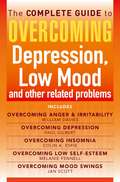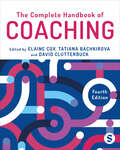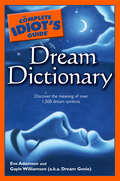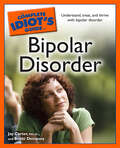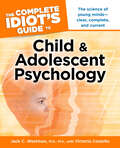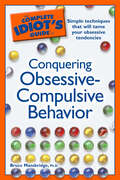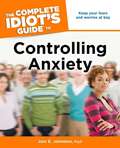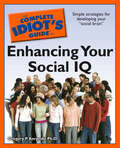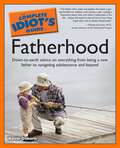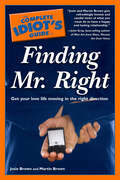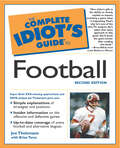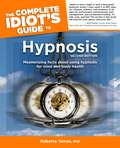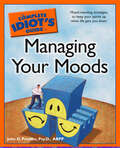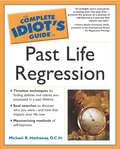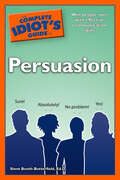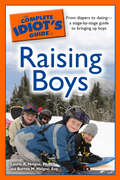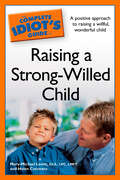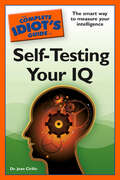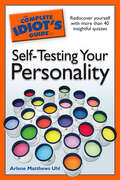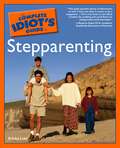- Table View
- List View
The Complete Guide to Overcoming depression, low mood and other related problems (ebook bundle)
by Jan Scott Melanie Fennell Colin EspieThis exclusive ebook bundle comprises five practical self-help programmes based on cognitive behavioural therapy (CBT) from the bestselling Overcoming series. Perfect for anyone experiencing problems with low mood or depression and associated problems such as low self-esteem, anger or sleep problems. This is also the perfect resource for therapists.Each book includes:-Case studies-Practical exercises-Monitoring sheetsOvercoming Depression - 3rd editionIf you suffer from depression you are far from alone. Depression is very common, affecting over 300 million people around the world. Written by Professor Paul Gilbert OBE, internationally recognised for his work on depression, this highly acclaimed self-help book has been of benefit to thousands of people including sufferers, their friends and families, and those working in the medical profession.This fully revised third edition has been extensively updated and rewritten to reflect over ten years of new research on understanding and treating depression, particularly the importance of developing compassionate ways of thinking, behaving and feeling.Overcoming Mood SwingsMost people know what it is like to experience high or low spirits. For some individuals, however, emotional extremes can seriously disrupt their lives, either because they happen too frequently or because the mood swings are intense and are accompanied by other symptoms of depression or mania (often referred to as bipolar disorder).This practical self-help guide provides background information on depression and mania and offers tried and tested techniques that will help the reader identify and manage their mood more effectively, and achieve a more stable emotional state.Overcoming Low Self-EsteemA self-help classic, winning acclaim for its practical and user-friendly approach and now recommended on the National Health Service's self-help scheme known as Books on Prescription. This book will aid readers to understand what has caused their low self-esteem and, with this knowledge, break out of the vicious circle of negative self-image, learn the art of self-acceptance and alter their lives for the better.Overcoming Anger and IrritabilityAn invaluable self-help guide to managing a widespread behavioural problem. This is a practical self-help programme for those who find that they are spoiling the lives of both themselves and those around them with their almost constant irritability and flashes of bad temper. It will help the reader understand why such behaviour occurs and what can be done to prevent it.Overcoming InsomniaExtensive research conducted over 25 years has established Cognitive Behavioural Therapy (CBT) as the treatment of choice for insomnia. For the first time, proven CBT principles have been brought together by a world-renowned expert on insomnia in a comprehensive self-help manual. In a clear step-by-step approach, new patterns of relaxation, sleeping and waking are quickly learnt. Based on clinically proven techniques.
The Complete Guide to Overcoming depression, low mood and other related problems (ebook bundle)
by Colin Espie Dr Melanie Fennell Prof Paul Gilbert Dr William Davies Professor Jan Scott MD, FRCPsychThis exclusive ebook bundle comprises five practical self-help programmes based on cognitive behavioural therapy (CBT) from the bestselling Overcoming series. Perfect for anyone experiencing problems with low mood or depression and associated problems such as low self-esteem, anger or sleep problems. This is also the perfect resource for therapists.Each book includes:-Case studies-Practical exercises-Monitoring sheetsOvercoming Depression - 3rd editionIf you suffer from depression you are far from alone. Depression is very common, affecting over 300 million people around the world. Written by Professor Paul Gilbert OBE, internationally recognised for his work on depression, this highly acclaimed self-help book has been of benefit to thousands of people including sufferers, their friends and families, and those working in the medical profession.This fully revised third edition has been extensively updated and rewritten to reflect over ten years of new research on understanding and treating depression, particularly the importance of developing compassionate ways of thinking, behaving and feeling.Overcoming Mood SwingsMost people know what it is like to experience high or low spirits. For some individuals, however, emotional extremes can seriously disrupt their lives, either because they happen too frequently or because the mood swings are intense and are accompanied by other symptoms of depression or mania (often referred to as bipolar disorder).This practical self-help guide provides background information on depression and mania and offers tried and tested techniques that will help the reader identify and manage their mood more effectively, and achieve a more stable emotional state.Overcoming Low Self-EsteemA self-help classic, winning acclaim for its practical and user-friendly approach and now recommended on the National Health Service's self-help scheme known as Books on Prescription. This book will aid readers to understand what has caused their low self-esteem and, with this knowledge, break out of the vicious circle of negative self-image, learn the art of self-acceptance and alter their lives for the better.Overcoming Anger and IrritabilityAn invaluable self-help guide to managing a widespread behavioural problem. This is a practical self-help programme for those who find that they are spoiling the lives of both themselves and those around them with their almost constant irritability and flashes of bad temper. It will help the reader understand why such behaviour occurs and what can be done to prevent it.Overcoming InsomniaExtensive research conducted over 25 years has established Cognitive Behavioural Therapy (CBT) as the treatment of choice for insomnia. For the first time, proven CBT principles have been brought together by a world-renowned expert on insomnia in a comprehensive self-help manual. In a clear step-by-step approach, new patterns of relaxation, sleeping and waking are quickly learnt. Based on clinically proven techniques.
The Complete Handbook of Coaching
by Elaine Cox Tatiana Bachkirova David ClutterbuckThis fourth edition provides the most comprehensive guide to the field of coaching, exploring a range of coaching theories and approaches, genres and settings and professional issues. It supports trainees and professionals to identify and develop a personal style of coaching. Each chapter includes discussion questions to facilitate reflection on the topic, further reading suggestions and case studies that help trainees make the crucial link between theory and practice. Its three parts cover: The theoretical traditions underpinning coaching such as cognitive-behavioural, gestalt and existential Contexts and genres such as life, executive, peer, team and career coaching Professional issues such as ethics, supervision, continuing professional development, standards and mental-health issues. This Fourth Edition comes with a new chapter on Diversity and Inclusion in Coaching, updated content throughout on cross-cultural coaching and updated Further Reading. A new online Teaching Guide provides chapter teaching and assessment suggestions, videos and further reading to help support trainees’ learning. Thousands of practitioners and trainees across a variety of professions have been helped by this distinctive handbook. From those working in health to education, from business and management to psychology, this unique handbook is an invaluable resource for any coaching career.
The Complete Handbook of Coaching
by Elaine Cox Tatiana Bachkirova David ClutterbuckThis fourth edition provides the most comprehensive guide to the field of coaching, exploring a range of coaching theories and approaches, genres and settings and professional issues. It supports trainees and professionals to identify and develop a personal style of coaching. Each chapter includes discussion questions to facilitate reflection on the topic, further reading suggestions and case studies that help trainees make the crucial link between theory and practice. Its three parts cover: The theoretical traditions underpinning coaching such as cognitive-behavioural, gestalt and existential Contexts and genres such as life, executive, peer, team and career coaching Professional issues such as ethics, supervision, continuing professional development, standards and mental-health issues. This Fourth Edition comes with a new chapter on Diversity and Inclusion in Coaching, updated content throughout on cross-cultural coaching and updated Further Reading. A new online Teaching Guide provides chapter teaching and assessment suggestions, videos and further reading to help support trainees’ learning. Thousands of practitioners and trainees across a variety of professions have been helped by this distinctive handbook. From those working in health to education, from business and management to psychology, this unique handbook is an invaluable resource for any coaching career.
The Complete Handbook of Coaching
by Elaine CoxThis comprehensive guide to coaching explores a full variety of coaching theories, approaches and settings, and offers strategies for the reader to identify and develop a personal style of coaching. The book is divided into three parts: - Part One explores the theoretical traditions that underpin the foundation for coaching such as cognitive-behavioural, Gestalt and existential. - Part Two covers applied contexts, formats or types of coaching such as life, executive, peer, team and career coaching. - Part Three focuses on professional issues that impact the coach such as ethics, supervision, continuing professional development, standards and mental-health issues. Written by leading international authors, each chapter makes explicit links between theory and practice and generic questions will facilitate further reflection on the topic. There are also suggestions for reading, and short case studies. This is the first book to explore the differences between the theoretical perspectives of coaching and the links between these perspectives in relation to contexts, genres and media of coaching.
The Complete Idiot's Guide Dream Dictionary: Discover the Meaning of Over 1,500 Dream Symbols
by Eve Adamson Dream Genie15,000 entries—from abduction to zebra . . . Everybody dreams—and now there&’s a dream dictionary for everyone! With 15,000 entries, this reference showcases the most up-to-date vocabulary of dream symbols, such as cell phones. It also includes a dream thesaurus with handy list collections of entries by topic; a dream quiz that offers revealing insights into your dream personality; a section called &“Tuck-in Time,&” which provides terrific strategies for inviting, inducing, and remembering dreams; and a dream interpretation checklist, helping readers interpret their dreams step–by–step.• Popular reference dictionary format• Focuses on symbols, meanings, and interpretations
The Complete Idiot's Guide to Adult ADHD: Don’t Let ADHD Distract You from Living!
by Eileen Bailey Donald HauptA thorough examination of a misunderstood condition Though it's traditionally thought of as a childhood disorder, a growing body of research is bringing awareness to the fact that ADHD often continues into adulthood, though its symptoms often take on a different form and make the disorder more difficult to diagnose. • Covers what ADHD looks like in adults, how symptoms can vary greatly from one person to the next, and how it often gets misdiagnosed • Includes information on related conditions that often coexist with adult ADHD, including depression and anxiety • Discusses various treatment options-pharmaceutical, behavioral, lifestyle, and alternative approaches
The Complete Idiot's Guide to Bipolar Disorder: Understand, Treat, and Thrive with Bipolar Disorder
by Jay Carter Bobbi DempseyClear answers on correctly diagnosing and living with bipolar disorder This comprehensive and reliable guide addresses how bipolar disorder is different from other disorders, the latest research into bipolar treatments, strategies for living with bipolar disorder, and much more.• Bipolar disorder is estimated to be the sixth leading cause of disability in the world, and the number of Americans diagnosed as bipolar may be as high as 10 million• The number of children and teens diagnosed as bipolar has more than tripled since 1994• Includes information on parenting a child with bipolar disorder
The Complete Idiot's Guide to Child and Adolescent Psychology
by Victoria Costello Jack C. WestmanSimplifying a complex subject. Child psychology is required for college level psych and elementary education majors. It is a complex subject that can include developmental psychology, biology, sociological psychology, and various schools of theory and therapies. The only sources of information about this complex subject are long, expensive textbooks. Until now. This, the first trade book to give a detailed, easy to understand explanation of the subject. Age-by-age discussion of the psychological development of children.
The Complete Idiot's Guide to Conquering Obsessive Compulsive Behavior: Simple Techniques That Will Tame Your Obsessive Tendencies
by Bruce MansbridgePractical help for the millions who suffer Over 6 million Americans and millions more around the world suffer from some degree of obsessive compulsive behavior. For the vast majority of these people, this behavior impacts the quality of their lives. However, OC behavior can be difficult to understand and even harder to change. The Complete Idiot's Guide® to Conquering Obsessive Compulsive Behavior is a practical guide created specifically for middle range sufferers to help them overcome OC behavior and take back control of their lives.• Millions of people from teens to seniors suffer from OC behavior• Written by a well-respected and acknowledged author in this field• Heightened awareness of the disorder thanks to the popular TV series Monk
The Complete Idiot's Guide to Controlling Anxiety
by Joni E. JohnstonGives readers the tools to soothe their nerves. Each year, about one-third of Americans have at least one panic attack, making anxiety disorders among the most common emotional problems. They affect approximately 19 million Americans--more than those suffering from depression, bipolar disorder, schizophrenia, or alcohol abuse. This indispensable guide separates fact from fiction to empower people to regain control over their minds and their lives, shows the differences between normal anxieties and extreme reactions, reveals methods of recognizing anxiety triggers and boosters, and offers calming techniques.
The Complete Idiot's Guide to Enhancing Your Social IQ: Simple Strategies for Developing Your “Social Brain”
by Gregory P. KorgeskiSimple steps to connecting with others. Now readers can raise their social intelligence quotient with a little self-knowledge and practice. Beginning with a series of short quizzes that generate a personal social profile, this guide explains how readers can enhance their ability to create and sustain mutually enriching relationships, make friends, and build a rich social network. • &“Social intelligence&” is the new buzz word in the psychology of relationships. • Includes social personality quizzes. • Hot, new self-help topic. • Author Gregory Korgeski, PhD, has more than 30 years of experience as a licensed psychologist.
The Complete Idiot's Guide to Fatherhood: Down-to-Earth Advice on Everything from Being a New Father to Navigating Adolesc
by Kevin OsbornYou're no idiot, of course. You know that life isn't like an old sitcom—when TV dads like Mike Brady or Ward Cleaver always had just the right answer for Greg, Marcia or the Beaver. But when it comes to earning the title "World's Greatest Dad," you feel like you're always going to be more like the father from Married with Children than the one from Father Knows Best. Don't retire your cardigan just yet! The Complete Idiot's Guide® to Fatherhood answers all the questions any expecting, new, or veteran father could have on topics ranging from communication and ground rules to privileges and punishment.
The Complete Idiot's Guide to Finding Mr. Right: Get Your Love Life Moving in the Right Direction
by Josie Brown Martin BrownIn a world of Mr. Right Nows, a guide to Mr. Right . . . Chock full of solid advice, this guide for women offers exercises to help the reader learn more about herself. She then uses that information to recognize mates with compatible qualities. In it are the five myths about Mr. Right, the seven deadly sins that women make while dating, how to spot Mr. Wrong, where to meet Mr. Right, dating DOs and DON'Ts, and much more. • From the editors of John Gray's MarsVenus.com and relationship editors of SingleMindedWomen.com
The Complete Idiot's Guide to Football, 2nd Edition
by Joe Theismann Brian TarcyThe Complete Idiot's Guide® to Understanding Football, Second Edition, provides new and intermediate football fans with all the information they need to understand and enjoy football. From high school to the NFL, coverage includes the basics of offense and defense, players, rules, strategies and even what to wear! New coverage for this edition includes: the draft—how it works for teams and players including parity, new technology on the field including instant replay, dangerous referee flags and rules changes for college and pro ball, XFL, arena league, expansion teams and NFL Europe, and the changing business and team strategy for professional football today.
The Complete Idiot's Guide to Hypnosis, 2nd Edition: Mesmerizing Facts About Using Hypnosis for Mind and Body Health
by Roberta TemesFrom treating cigarette addictions to losing weight, from setting career goals to getting a good night's sleep, this updated second edition by noted psychologist and hypnotherapist Roberta Temes shows how to use hypnosis responsibly to improve one's quality of life. Includes updated step-by-step instructions for self-hypnosis, plus clear explanations of what hypnosis is and how it works, tips for finding a reputable hypnotherapist, tips on solving problems in one's love life, career, health, and more.• First edition is the bestselling book on hypnosis on the market• Revised and updated with more thorough step-by-step instructions for self-hypnosis• Author websites: www.drroberta.com and www.hypnosisbyphone.com"Want to kick a habit or a field goal? The secrets in this book will improve your game and your life." - Bob Reese, Peak Performance Specialist
The Complete Idiot's Guide to Intimacy
by Dr. Paul ColemanThe comprehensive guide to getting close—and closer . . . Renowned psychologist Dr. Paul Coleman gives readers a step–by–step, clear path to improving their relationships by helping them identify intimacy problems, understand key differences between men and women, change perceptions, overcome arguments, and effectively communicate. He also covers sexual intimacy and affection issues, including intimacy during stressful times, transitions, and as relationships progress. This book is a beacon for those looking to solve their struggles with intimacy.• Tools and exercises for both physical and emotional intimacy• Self-assessment tests and exercises to help pinpoint issues• For couples, singles, and families, men and women• Coleman is an expert with an active practice and specialty in intimacy issues who&’s made appearances on Oprah, Today, and Geraldo
The Complete Idiot's Guide to Managing Your Moods
by John PrestonNow, mood management is in everyone's reach. Anger. Depression. Anxiety. Low self-esteem. With the help of this guide, millions of Americans can stop suffering from these difficult emotions. Written by a prominent psychologist, this book is chock-full of the many strategies and approaches that have proven effective over the years. And since one size does not fit all, it includes information on self-help and counseling, psychiatric medication and psychological therapy, physical exercise and cognitive behavioral therapy. Offers a number of time-tested and scientifically proven approaches to managing moods Addresses fears and myths regarding treatment Will be helpful to a variety of people, including those suffering from alcoholism, drug addiction, bipolar disorder, depression, postpartum depression, and chronic pain
The Complete Idiot's Guide to Past Life Regression
by Michael HathawayA guide to the mysteries of your past . . .In this fascinating book, a board-certified past life regression therapist goes beyond reincarnation and karma to reveal everything people want to know about the ins and outs of this phenomena. This book covers: • Whether past life regression is for real• What to expect from hypnosis• Whether children are closer to their past lives than adults• How knowledge of past lives can help resolve issues and improve the present
The Complete Idiot's Guide to Persuasion: Win People Over with Effective Communications Skills
by Steve Booth-ButterfieldGet your way . . . the smart way. Persuasion is the art of changing the way people think, feel, and act through the use of language. The Complete Idiot's Guide® to Persuasion provides strategies for the readers to master the art of persuasion in a positive manner. By using time-honored tools of communication, body language, and psychology, readers can use persuasion to do good things like convince kids to eat their veggies, women to get annual mammograms, and couples to communicate without arguing.• A practical book based on sound academics to help communications and psychology majors as well as businesspeople, salespeople, performers, teachers, and parents• Tips and tactics for writers and public speakers
The Complete Idiot's Guide to Raising Boys: From Diapers to Dating—a Stage-By-Stage Guide to Bringing Up Boys
by Laurie A. Helgoe Barron M. HelgoeA positive look at parenting sons Here's a hands-on parenting guide that takes readers from the birth of their sons to the day they head off to college. In warm, wise words, the husband–and–wife team who are parents of two sons themselves, explore all that is different and the same, precious and at times irritating, about the boys in their lives. • Written by parents of a pair of teenage boys • Offers a unique positive perspective • Full of practical parenting tips • Topics covered include school, discipline, puberty, bullies, girls, and much more
The Complete Idiot's Guide to Raising a Strong-Willed Child
by Helen Coronato Mary-Michael LevittWhen "because I'm the parent" meets "you're not the boss of me" . . . Good news: there are many ways to parent willful children without everyday clashes. Here parents learn how to capitalize on children's strengths and make bad days more manageable. Full of ideas and techniques, it explores: how to use empathy first and discipline second; exercises and strategies that work to calm toddler tantrums; bringing teachers on board; raging hormones in teen rebels; and dealing with health and safety issues. • Much more positive than other parenting books, which focus on discipline and parental control • Helps parents understand and accept children for who they are, as well as who they can hope to be
The Complete Idiot's Guide to Self-Testing Your IQ
by Dr. Jean CirilloAn enjoyable and entertaining way to measure brainpower. The Complete Idiot's Guide® to Self-Testing Your IQ provides readers with tests that can be used to estimate a realistic IQ score, as well as games, puzzles, and more for an engaging and exciting workout for the mind. Using an amusement-based approach, IQ expert Dr. Jean Cirillo presents fun questions and answers that are rooted in standard IQ testing. Tests and games included are designed to measure cognitive skills, reasoning abilities, problem-solving capabilities, verbal abilities, mathematics and calculation skills, short- and long-term memory, and much more Because the tests are separated by area, this book has a strong "flip-through" factor, offering readers tests to be completed in one sitting for a comprehensive score, or as many or as few per sitting as time permits
The Complete Idiot's Guide to Self-Testing Your Personality
by Arlene UhlIt really is all about you! Everyone loves taking personality tests. Presented in an easy-to-read format, this collection of entertaining and insightful self-scoring quizzes lets readers explore different aspects of their personalities with tests, such as &“Am I a Risktaker?&”; &“Am I in the Right Career?&”; &“My Flirtation IQ&”; and &“Am I a Spender or a Saver?&” • Personality tests are hot—a Google search for &“online personality tests&” produces over 3,150,000 hits • Personality tests are a staple in magazines, such as Cosmo, Glamour, and Men&’s Health as well as online sites.
The Complete Idiot's Guide to Stepparenting
by Erika LutzYou're no idiot, of course. You know how to push a toddler on a swing, the recipe for the gooey chocolate chip cookies, and even how to get teens to confide in you. Your own kids think you're hip, too (although they'd never admit to it). But when it comes to figuring out how not to come across as the wicked stepparent, you feel like you need a magical potion. Don't reach for the garlic yet! The Complete Idiot's Guide® to Stepparenting gives you sanity-saving advice for dealing with the stepfamily, getting to know your stepchildren, and feeling confident in your role.
